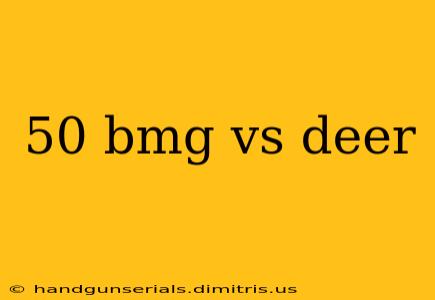The question of whether a .50 BMG rifle is suitable for hunting deer sparks considerable debate. While its immense power might seem like an advantage, ethical concerns and practical limitations make it a highly controversial choice. This article delves into the complexities of using a .50 BMG for deer hunting, examining the ethical implications, ballistic performance, and overall practicality.
Ethical Considerations: Overkill and Respect for the Animal
The most significant argument against using a .50 BMG for deer hunting centers around the concept of overkill. This powerful cartridge delivers far more energy than necessary for ethically harvesting deer. The excessive force often results in significant tissue damage, causing unnecessary suffering to the animal. A clean, quick kill is paramount in ethical hunting, and the .50 BMG's potential for excessive damage compromises this fundamental principle. Responsible hunters strive for a humane harvest, minimizing the animal's pain and distress, and the .50 BMG often falls short of this standard.
Furthermore, the sheer destructive power of the .50 BMG raises concerns about shot placement accuracy. Even a slightly off-target shot can result in catastrophic damage, rendering the animal unusable and leading to significant waste. The precision required to ensure a humane kill with this cartridge is exceptionally high, demanding a level of marksmanship far beyond what is typical for deer hunting.
Ballistic Performance: Power vs. Precision
The .50 BMG's ballistic performance, while impressive, is not necessarily advantageous in a hunting context. Its extreme power leads to significant recoil, making follow-up shots difficult and potentially dangerous for the hunter. Furthermore, the massive bullet's trajectory is heavily affected by wind, demanding even more precise aiming. These factors combine to significantly increase the difficulty of achieving a clean kill, emphasizing the ethical considerations mentioned above.
While the .50 BMG boasts exceptional range, it's practically irrelevant for deer hunting. Ethical hunting typically occurs at significantly shorter ranges, where the cartridge's excessive power becomes a liability rather than an asset. The risk of overpenetration and collateral damage increases dramatically at close range, making it a dangerous choice in densely populated areas or close to structures.
Practical Limitations: Accessibility, Cost, and Logistics
The practical aspects of using a .50 BMG for deer hunting further discourage its use. These rifles are expensive, both to purchase and to maintain. Ammunition is also significantly more costly than that used for typical deer hunting calibers. Furthermore, the size and weight of the rifle and ammunition make it cumbersome for hunting, limiting mobility and accessibility in the field.
Accessing legal hunting grounds with such a powerful firearm could also present challenges. Many jurisdictions impose strict regulations on the use of high-caliber rifles for hunting, potentially prohibiting the use of a .50 BMG altogether.
Conclusion: A Mismatch for Deer Hunting
In conclusion, while the .50 BMG is a potent and impressive cartridge, its use for hunting deer is ethically questionable and practically impractical. The excessive power, significant recoil, high cost, and potential for extensive damage outweigh any perceived advantages. Numerous other calibers provide effective and humane options for deer hunting, aligning with ethical hunting practices and offering superior practicality in the field. Respect for the animal and responsible hunting practices should always guide the choice of firearm and ammunition. Choosing a cartridge appropriate for the task is crucial for ensuring a quick, clean, and ethical hunt.

